Table of Contents
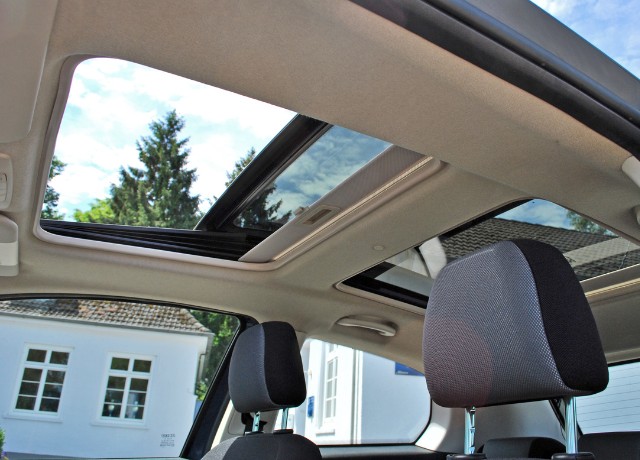
Introduction:
Leaving your car’s sunroof open can be a refreshing way to enjoy the breeze on a sunny day. However, if you forget to close it and a sudden rainstorm hits, you may find yourself dealing with water damage in your car. Water damage can cause mold and mildew growth, as well as damage to electrical components in the car.
Left my sunroof open in the rain is a common mistake that many car owners have faced. In this article, we will guide the steps on how to dry out car after leaving sunroof open and prevent more damage.
Damages To Expect If Sunroof Left Open During Rain:
I left my sunroof open and it rained, it means you put yourself and others in danger. In the event of a rainstorm, the interior of the vehicle will quickly get flooded. In addition, the following are possible if there happens to rain in the sunroof:
Damage in External Parts:
Leaving your sunroof open during a rainstorm can cause some severe damage to your external parts such as the accelerator, clutch, and brake.
Corrosion of the accelerator’s interior parts by water is the most likely initial effect. The rust and rust spots on the engine block make it difficult to speed up, and eventually, they can cause the car engine to seize up completely.
If enough moisture gets into the clutch, it can be destroyed, making shifting gears difficult or perhaps turning the transmission inoperable.
Finally, if water gets into the brakes, it could cause the pads to wear out or the calipers and rotors to freeze, all of which are dangerous.
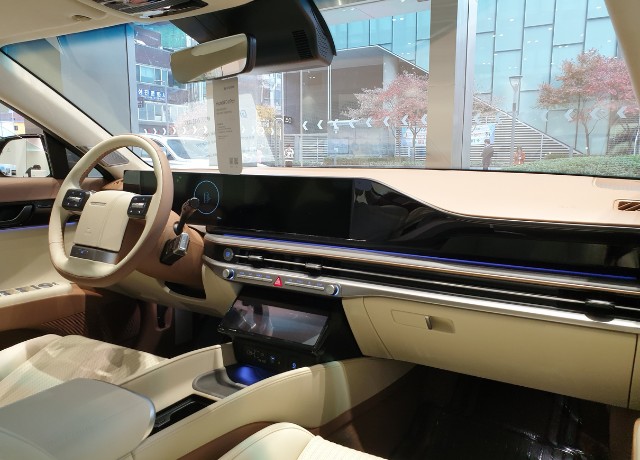
Car Electrical Problems After Rain:
Our car’s interior is loaded with electronic conveniences, such as exterior and interior lights, turn signals, navigation system, climate control, speaker and radio systems, power windows and car seats, power door locks, and more.
Car electrical problems after rain are common since the rainwater can readily get to the sensitive electronics within. This creates a risk of fire and can cause short circuits that damage your car’s electronic systems.
Avoid touching any electrical system until it is dry, as even a small amount of moisture can cause a deadly electric shock.
Other Interior Damages:
Left sunroof open in rain leather seats can be a costly mistake. The damage caused by wet leather upholstery and damp car seats can be significant. If the sunroof left open in the rain, you expose yourself not just to the apparent risk of water damage, but also to the risks of falling debris and other hazards.
When leather upholstery becomes damp, molds and mildew can quickly become an issue. The dark, moist environment created by wet leather is an ideal breeding ground for these organisms, which have the potential to cause severe allergic reactions in some people.
And once molds have taken hold in leather upholstery, they can be next to impossible to get rid of without the intervention of a professional cleaning or restoration specialist.
In addition, the presence of molds is sometimes accompanied by a strong odor owing to wetness in the car interior, making driving an unpleasant experience for you and your passengers.
Rust:
The most common damages that occur when a sunroof is left open during rain include rust and corrosion of metallic components such as screws, bolts, thread starters, and servos.
Rust is not only unpleasant to look at, but it can also compromise your car interior, making it unsafe to drive. Water has the potential to enter into all gaps inside the car, significantly reducing its structural strength.
Rust forms on metal that has been subjected to water and oxygen for an extended period of time. As this occurs, rust forms as the metal corrode and get worn away over time. So causing permanent harm.
Hydrolock:
Hydrolock happens when water gets into the car engine and prevents air from getting into the cylinder’s combustion chamber, causing the engine to stall. This can cause irreparable damage to an engine, resulting in expensive repairs or even more costly replacement.
There are a lot of issues that can arise from a hydro lock, including decreased engine power and sluggish acceleration. You may also hear unusual noises coming from the engine compartment or have trouble starting your vehicle.
Because of the lack of lubrication that can occur when water mixes with oil or gasoline in the cylinder’s combustion chamber, a hydro lock can cause catastrophic engine failure.

How To Dry Out Car After Leaving Sunroof Open?
If you’ve just noticed rain in the sunroof, you need to take urgent action to dry off your car. Simply comply with the detailed instructions on how to dry out car after leaving sunroof open, and you’ll be good to go. But make sure to take immediate action:
Assess the Damage:
Checking the extent of the damage is the first step in drying out your car. There’s a chance you can dry out your car floor on your own if only a tiny amount of water got in. But if there’s a lot of water, it’s best to call in the experts.
Look for damp spots on the carpet and upholstery. Avoid starting the vehicle if the power car seats or electrical system are damaged; this could result in fire or explosion.
Remove Any Standing Water:
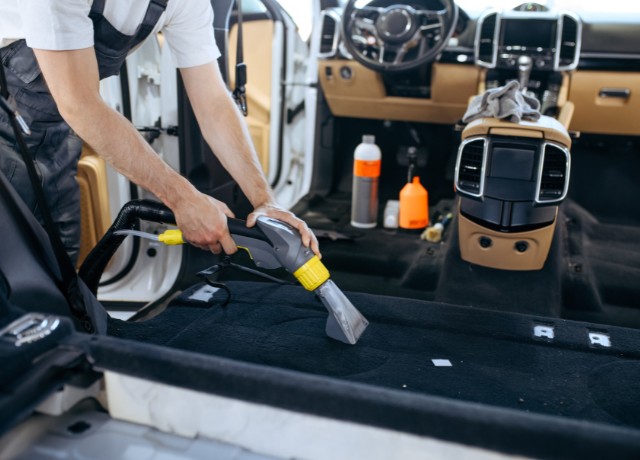
The next step is to drain the car floor of any accumulated water. To remove as much moisture as you can, you should use cloth towels or a wet/dry vacuum. Completely remove any moisture from carpets, car seats, and other fabric surfaces by vacuuming.
You can easily remove the remaining water by using floor drain plugs if you have any in your car. Plus, to make things easy remove seats so that you will have better access to all damp spots to remove excess water.
To stop the spread of mold or mildew, it’s crucial to get rid of the water as quickly as possible. It’s important to dry off the entire car, including the trunk, the floor, and the cushions.
Use Fans or a Dehumidifier:
In order to prevent more damage, it is not enough to simply remove the excess water; the wet car interior must be completely dry. A fan or dehumidifier will serve you well in this regard.
To accelerate the drying process, position electric fans inside the vehicle so that the airflow is directed toward the damp spots. Excessive humidity in the air can also be reduced with the help of dehumidifying cars after rain in the sunroof.
The best way to prevent moisture buildup inside the car is to increase its air circulation. Air can circulate better inside the car if the driver or passengers leave the doors or windows open for a while, helping to eliminate musty aromas and stop the growth of molds.
Avoid Using Heat:
To completely dry the car with heat may seem like a good idea at the time, but it really causes more damage. Extreme heat can ruin electronics and encourage the growth of mold or mildew. Drying the vehicle off is best done with electric fans and fresh airflow.
Clean and Disinfect:

As soon as the vehicle dries out, you should clean and disinfect the affected regions. Surfaces that may have come into touch with the water should be cleaned with a disinfectant spray or solution. In addition to removing any remaining scents, this will assist to prevent the growth of mold and mildew.
It is also advised to replace the car’s cabin air filter as well to ensure maximum care. Plus, make sure to remove foul odors from the interior.
Inspect the Car:
Once you’re done drying and cleaning the vehicle, make sure to look it over for any signs of damage or mold. It’s important to look for evidence of wear on the upholstery, carpeting, engine and electrical system. Get expert assistance if you see any damage.
Avoid Starting The Car:
After a thunderstorm, water may have already made its way into the engine, and starting it could invite even more water within. Turning on the car’s engine if water is already inside could cause more damage.
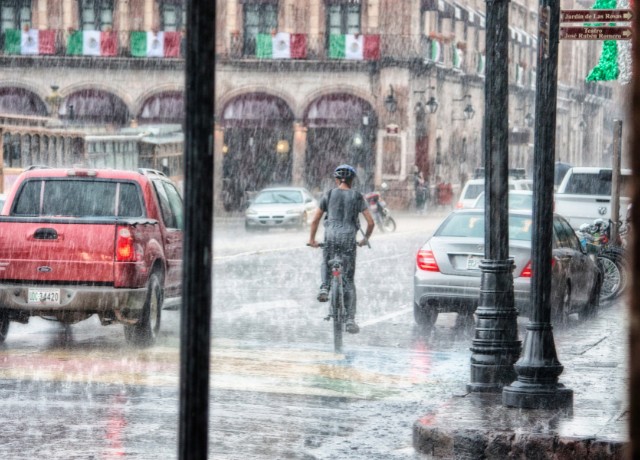
Prevent Future Water Damage:
If you want to avoid water damage in the future, you can take precautions. One piece of advice is to not leave the sunroof open while the car is parked. Close the sunroof if precipitation is in the forecast.
For similar protection from snow and rain, a car cover is another useful suggestion. Mold can be prevented with the help of a moisture absorber if you reside in a humid location.
FAQ:
Q: How Do I Know My Sunroof Is Leaking?
A: You may notice water stains or dampness on the headliner or upholstery, a musty smell in the car, or water dripping inside the car when it is raining or wet outside. In some cases, you may also hear a sloshing sound or notice water pooling in the footwell of the car.
Q: How To Dry Out Car After Leaving Sunroof Open In Rain?
A: Left my sunroof open in the rain, the following are the things you need to do to dry it out:
Access the damage
Remove any excess water
Use a fan or dehumidifier
Avoid using heat
Clean and disinfect the wet car interior
Inspect the car
Q: Can You Air Dry A Car By Driving It?
A: While driving with the windows down can help to circulate air and promote drying, it is not recommended as a primary method of drying out a wet car.
The car’s interior should be thoroughly dried using paper towels, air circulation, and/or a dehumidifier to prevent damage to the car’s electronics, upholstery, and other components.
Q: What Could Happen If I Left Sunroof Open In the Rain?
A: I left my sunroof open and it rained can allow water to enter the car’s interior, potentially causing damage to upholstery, electronics, and other components. It can also create a breeding ground for mold and mildew, which can be harmful to both the car and its occupants.
Q: How Do You Get The Moisture Out of A Car?
A: The best way to get the moisture out of a car is to first remove any standing water or excess moisture with a towel or absorbent material or by using vacuum cleaners. Then, leave the car windows and doors open to allow air circulation and promote drying.
Using a dehumidifier or fan to improve airflow can also help to get rid of moisture.
Q: Is the Sunroof Easy to Break?
A: Sunroofs are often not very fragile. A tempered glass sunroof, standard on most new vehicles, can sustain significant force without breaking. As a result, the sunroof would be very difficult to shatter without the use of heavy equipment or other objects.
Any damage to the sunroof, such as from a rock or extreme temperatures, might increase the likelihood that it will shatter.
While it is possible to break a sunroof in specific situations, the vast majority of modern types are built with safety and durability in mind and should not break under normal use.
Q: How Do You Tell If Your Sunroof Drain Is Clogged?
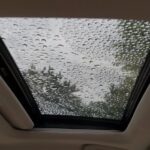
A: To know if the sunroof drain is clogged, look inside the car at the carpeting near where the sunroof drain should be located. If it’s wet or discolored, then you know that the water isn’t draining properly. You may also hear a sloshing sound when driving, or notice a musty smell in the car.
Q: Does Rain Get In The Sunroof?
A: If the sunroof is closed properly and functioning correctly, rain should not be able to get inside the car through the roof window. However, if the sunroof left open in the rain, rain water can enter the car’s floor.
Q: How Long Does It Take For A Car To Dry Out After Leaving The Sunroof Open?
A: When the sunroof left open in the rain, drying time might range from a few hours to a few days, depending on environmental conditions like humidity and airflow. Generally, it can take several hours to a day or more to fully dry out a car after you left sunroof open in rain.
Q: Can Leaving The Sunroof Open Cause Damage To The Car’s Interior?
A: Yes, leaving the sunroof open can cause damage to the car’s interior by allowing water to seep into the upholstery, carpets, and electronic components. This can lead to mold and mildew growth, as well as corrosion and other forms of damage.
Q: How Can I Prevent Mold And Mildew From Forming In My Car After Leaving The Sunroof Open?
A: In order to prevent the growth of mold and mildew in your vehicle after keeping the roof window open, you should dry it out as soon as possible and clean and disinfect all locations that may have been exposed to moisture.
Products like moisture absorbers and dehumidifiers can also be used to cut down on moisture within a vehicle.
Q: Is It Safe To Use A Hair Dryer Or Blow Dryer To Dry The Car After Leaving The Sunroof Open?

A: Using a hair drier or fan to dry out a car after leaving the sunroof open is generally safe, so long as you take the necessary steps to prevent overheating the vehicle and potentially damaging the interior or electronic components.
It’s best to keep the temperature low and divert the airflow away from the car’s upholstery and electronics. Hot air from the hair dryer can cause more damage than we think.
Final Words:
In conclusion, leaving your car’s sunroof open can lead to water damage, but it’s possible to dry out your car and prevent further damage. The most important thing is to act quickly to analyze the situation, drain the water, dry up the car’s interior, and take precautions to prevent further water damage.
Remember, it’s essential to act fast to avoid mold growth and further damage. If you have any experiences with leaving your sunroof left open in the rain or tips for preventing water damage, share them with us in the comments below. Thanks!






















































